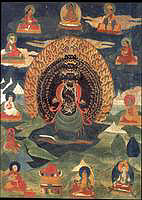
|
Tutelary Deity (painting no. 277)
|

View Larger Image |
||||||||||||
|
The King of the Nagas stands at the center of this thangka, which depicts the transmission of the Dharma. The Naga King guards the depths of the sea, and is famous for guarding the treasures of the Mahayana and Vajrayana teachings. These teachings came from India to the heights of the Land of Snows, Tibet, either over the mountains or along the Silk Route. This painting graphically depicts a monk sitting with a merchant, between them bunches of goods, bolts of cloth, and a container of precious stones—at the peak of which is the Coin of the Dharma, indicating that traders and monks traveling together traded in wealth both of the world and of the teachings of the Enlightened One. The Monk sits with his hands in the mudra of teaching. The merchant holds a mongoose, a token of prosperity (for they spit out jewels), and his hand in the gesture of giving or patronage. At the side is the Goddess Tara, protecting from all fear with eyes on hands, feet and forehead, but garbed as an ordinary woman, with her hands in the mudras of giving and protecting. We might understand this trio to represent the classes of individuals involved in the transmission: Teachers, Merchants, and Women. Just above this trio are, to our left, a man sitting on a tiger skin. dressed in bone jewelry and holding a skull cup and a trident, the signs of a Siddha practitioner, one who seeks the worldly and supermundane powers. The ornaments are those of the Kapalika school of Siddhas, known for austerity and dwelling in lonely places. Just above him is an individual dressed with the white cotton of a lay practitioner, with his hair tied in a knot on top. His hands are in the mudras of giving and protecting, indicating perhaps, that the wealthy laity on the routes of transmission might be relied upon for safe passage. Above him is a turbaned individual, wearing a thick wool shirt, and with a red shawl. His hands are in the gestures of protecting and secreting. The face and costume are common to northern Persia, or Orgyen. The mudras indicate that at this point the transmission is protected and kept secret. Still above him is a king, possibly Song Tsan Gampo, wearing a crown and golden ear-rings. He sits on a mat. His hands are in the position of teaching the Dharma, while the skull cup that indicates esoteric transmission is in his left hand. This shows that the transmission to the Tibetan royal dynasty included the recognition of the monarch as a teacher and holder of secrets. Now, on the right side of the Thangka, just above Tara as an ordinary woman, there is an Indian monk, characterized by his lower robe, lack of shirt, and saffron shawl. He sits looking right at the Naga King, as all do, but has his hands in the Earth-Touching Mudra—the declaration of enlightenment. Nagarjuna, a monk and the hero of the Mahayana tradition, went to the bottom of the sea, it is said, and gained from the Naga King the scriptures of the Perfection of Wisdom, and based on them wrote many treatises on the Middle Way (Madyamika). Above him is another monk, with a book stashed in his robe, and with his hands in the mudra of teaching, showing the continued teaching of the transmission by the monastics in the course of the transmission. The dark red color of his robes shows that he represents a Tibetan, while the book in his hand indicates that he is a carrier of teachings. And at the highest position on the right we see a Tibetan Lama who is also a fully ordained monk. He, like his kingly counterpart to the left, bears implements of esoterica. His hands are in the mudra of teaching, and in his left he holds a skull cup—just as the royal figure opposite him, but in his right he holds a Vajra, a scepter of power, indicating he not only has esoteric knowledge, but the power to enact it. He, like the king, is crowned, but here with a "Vajra Crown." The front of the crown as the sickle moon with the solar disk, while the top has the power symbol of the Vajra. It is here, at the top of the image, that we see how the transmission of non-monastics, on the left of the painting, and of the monastics on the right, reach a balance at the highest point of the image, showing the principle of the balance of religion (chos)and politics (srid) established by Song Tsen Gampo. At the top middle of the painting sits the Buddha of Limitless Light, Amitabha. He is the Buddha of the West in the five Buddha mandala, and the progenitor of Avalokitesvara, Tara, and Padmasambhava. His family (Skt.: kula) is called the Lotus family, for just as a lotus grows out of the slimy mud and through the water to bloom into a beautiful flower in the light, so living beings may spring forth from the crud of mundane existence to rise up into their own enlightenment. That "Limitless Light" sits directly over the Naga King is also an indication that even the greatest powers of the world must have light above them for their power to be meaningful. It should also be noted that the Naga King, here, is depicted with the same heads and arms as Avalokitesvara in Thangka No. 88, while Avalokitesvara is the direct emanation of Amitabha. The image therefore carries an implication that the Naga King himself is also an incarnation of the compassionate principle of enlightened energy and born from light. S. Jeffries
|
|||||||||||||
Photographed Image Copyright © 1998 Shelley & Donald Rubin Foundation
|
|
| |
Next Image |